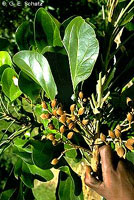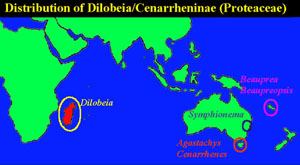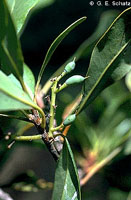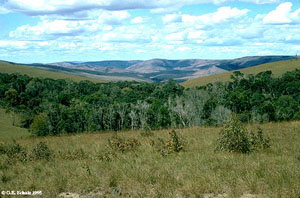 |
QUICK SEARCH
MO PROJECTS:
Africa
Asia/Pacific
Mesoamerica
North America
South America
General Taxonomy
Photo Essays
Training in Latin
America
MO RESEARCH:
Wm. L. Brown Center
Bryology
GIS
Graduate Studies
Research Experiences
for Undergraduates
Imaging Lab
Library
MBG Press
Publications
Climate Change
Catalog Fossil Plants
MO DATABASES:
W³MOST
Image Index
Rare Books
Angiosperm
Phylogeny
Res Botanica
All Databases
INFORMATION:
What's New?
People at MO
Visitor's Guide
Herbarium
Jobs & Fellowships
Symposium
Research Links
Site Map
Search
Malagasy/Indo-australo-malesian Phytogeographic ConnectionsLong Distance Dispersal | Conclusion | References Proteaceae The studies of Johnson & Briggs (1981) have revealed two independent relict lines of Proteaceae in Madagascar. Isolated dioecious Dilobeia (2 spp.), the sole member of subtribe Dilobeiinae appears to be sister to the subtribe Cenarrheninae consisting of two monotypic genera on Tasmania (Agastachys and Cenarrhenes), two genera endemic to New Caledonia (Beaupreopsis (1 sp.) and Beauprea (12 spp.; with fossil distribution in Australia and New Zealand)), and a more xeric taxon Symphionema (2 spp.) in N.S. Wales. From a base number of N = 14 for subfamily Proteoideae, chromosomal evolution indicates aneuploid reductions from Cenarrhenes (N = 14) to Agastachys (N = 13), Beauprea and Beaupreopsis (N = 11), and Symphionema (N = 10), as well as polyploidy in Dilobeia (N = 24).
Subtribe Hicksbeachiinae of subfamily Grevilleoideae is comprised of Malagasia (1 sp.) in Madagascar, Athertonia (1 sp.) and Hicksbeachia (2 spp.) in N.E. Australia, Virotia with 6 spp. probably endemic to New Caledonia (plus 1 sp. doubtfully placed in the genus from Queensland), and Heliciopsis with 7 spp. restricted to W. Malesia. Relationships among the genera are not fully resolved, but if Malagasia is most closely related to Heliciopsis as suggested by Johnson & Briggs (1981), then one could propose rafting of the ancestors of Heliciopsis on India, dispersal into W. Malesia, and subsequent extinction in India.
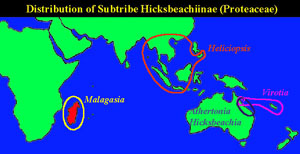
|
© 1995-2025 Missouri Botanical Garden, All Rights Reserved
4344 Shaw Blvd.
St. Louis, MO 63110
(314) 577-5100
Technical Support
